

If you have not yet sailed along the Aeolian coasts, reading this article you will discover that the Archipelago is a must among the itineraries of navigation in the Mediterranean, especially if you are tireless sailors in search of coves, bays and marinas, different every day. The lava nature of the Archipelago makes them particularly special, united by an origin of Fire, but extremely different in flora and fauna. The two furthest islands, Filicudi and Alicudi, are wild and deserted, Lipari and Panarea are gentler and more inhabited, Salina is solitary, and Vulcano and Stromboli are, one could say, brimming with light, the only mouths of fire that still erupt lava.
The wonder that turns these islands, often called the seven sisters, has been sung and romanced by countless poets and writers. The poet Franco Leone writes:
Seven volcanoes outcropping from the sea,
two still active but five now extinct,
in front of the Nèbrodi seem to wander,
kingdoms of breezes, storms and winds.
Unheard of forces have been able to shape,
with the fusion of the four elements,
seven small islands wonderful and amène
in the archaic era of the Pleistocene.
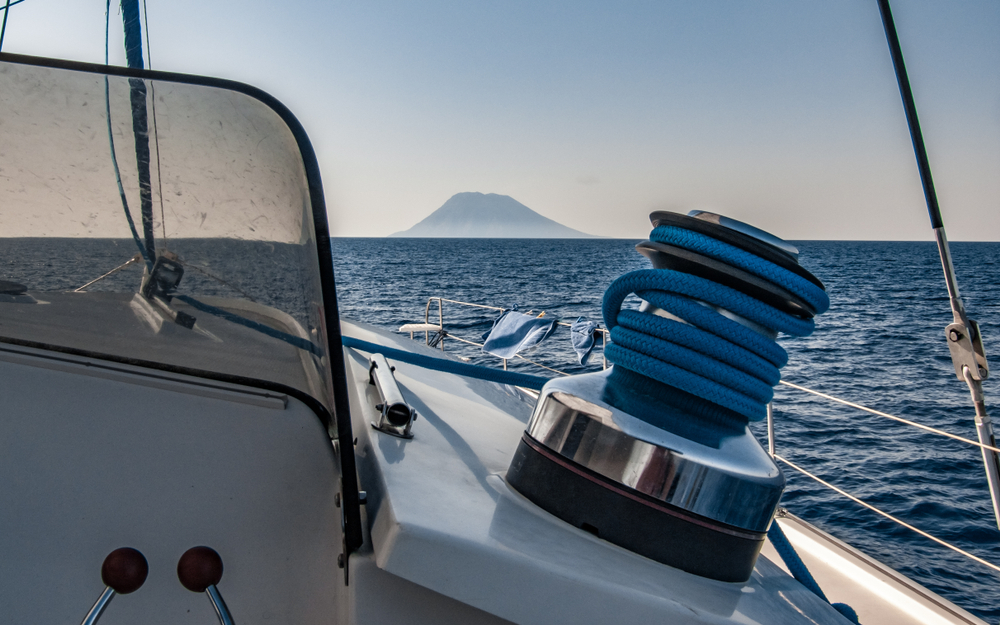
Sailing in the Tyrrenean Sea towards Stromboli
Appointed in 2000 by UNESCO as World Heritage Site, the Aeolian Islands owe an enchanted journey in this wonderful archipelago of Sicily between pristine sea, wild nature and volcanoes never dormant.
In 2000 UNESCO recognized the Aeolian Islands as a World Heritage Site, not only for their natural beauty but also for the care with which the inhabitants have made nature and human action coexist on the environment.
What makes the Aeolian Islands so unique is their morphology that has gone to form over the millennia by volcanic activity and the action of sea and wind. Exploring the Aeolian Islands by boat certainly offers the beauty of fully enjoying their natural diversity without the hassle that is so typical of visiting any place from the land.
Vulcano, the third largest island, the closest to the Sicilian coast. To distinguish it from the others, it is above all the great crater inactive since 800, but it is not the only peculiarity of this wonderful tourist destination. Today the main volcanic activity is constituted by fumaroles, visible in different areas of the island. Here are the places to discover by sailing to Vulcano.
Spiaggia del Gelso - This area of the island was mainly used for the cultivation of vineyards. Black sandy and pebbly beach, generally not very frequented, dominated by a very suggestive lighthouse and from which it is possible to admire the Saracen coast as well as Mount Etna. Very easy to reach by boat. A few meters from the beach there is a small bar-restaurant - Trattoria da Pina - which, at lunchtime, becomes a real beating heart: excellent pizzas and Aeolian schiacciatine, but also a little more elaborate dishes, all under the banner of Mediterranean and Aeolian cuisine.

Can one say no to the Aeolian Schiacciata?
Spiaggia delle Sabbie Nere - It is characterized by the colour of the sand of volcanic nature. This protected bay connects the east port to the former island of Vulcanello, with a gradual descent into the water and not too deep, ideal for children. The crystal clear water of the sea contrasts with the dark background of the lava stones and the play of light created by the sun's rays gives reflections similar to those of crystals. Att sunset, there are fiery red shades that will surprise you. We advise you to wear dark-coloured swimsuits because the black sand is so thin that it even gets into the fabrics!
Le Zone dei fanghi- There are three spots worth mentioning: the Mud Pool, the Hot Sea or Hot Water and the Fumarole.
La Pozza' dei fanghi (the Mud Pool): it was realized in the 60's thanks to the removal of the superficial crust of the fumarole area. In its waters dissolve the beneficial vapours of sulfur and its beneficial properties. Its fine clayey mud is a panacea for the body and skin of tourists from all over the world.
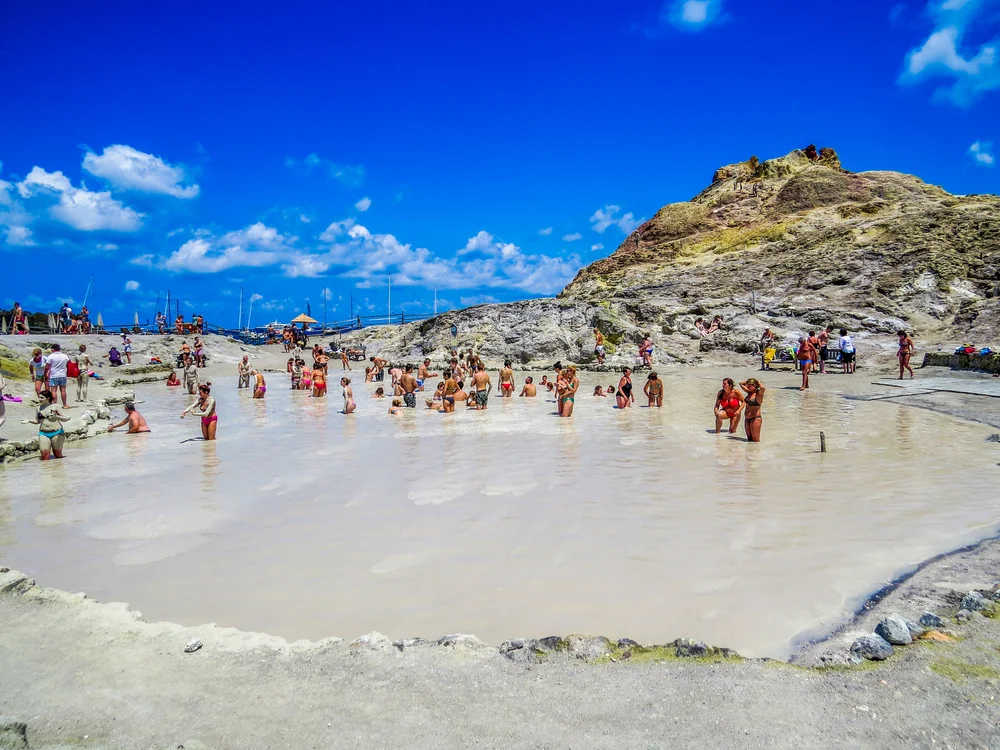
Your open-air spa in Vulcano
Near the natural pool of Mud, there is the hot sea and in continuous ferment, the area called just Acqua Calda (Hot Water), a stretch of sea where you can relax and finish the "cure" and rinse with an effective natural whirlpool. The underwater fumaroles emit steam at high pressure, on which you can pleasantly lie down getting beneficial whirlpool effect, all-natural!
Not far from the hot waters, you will find the Fumarole where you can make thermal inhalations.
These open-air spas have been exploited and controlled since time immemorial without any particular commitment and above all without fear that this source of well-being could be exhausted. It is important, however, as with all natural resources, to take advantage of these places in full respect of the natural context in which they are located in order to ensure that this is an experience that future generations can enjoy.
Panarea, the smallest of the Aeolian archipelago, arouses considerable naturalistic interest due to the variety of its environment.
The centre of Panarea is a picturesque tangle of alleys and narrow streets, which is definitely worth a walk. But there is much more: Panarea is also traditions, folklore and art. Among the places of interest to visit, we point out the small church of San Pietro and the church of the Assunta, that in their simplicity and for their view on the spectacular sea of the Aeolian Islands, are unmissable for those who arrive on the island. The prehistoric village of Capo Milazzese is the most important archaeological site of the island and testifies the ancient roots of Panarea.
Located on the eastern side and in the southern part of Panarea, the sandy beaches are worth a boat stop. From Panarea, you can easily reach the islands of Basiluzzo and Lisca Bianca, where there are other beautiful sandy beaches. Let's explore together the main ones, starting from Cala Junco which is located near the prehistoric village of Punta Milazzese.
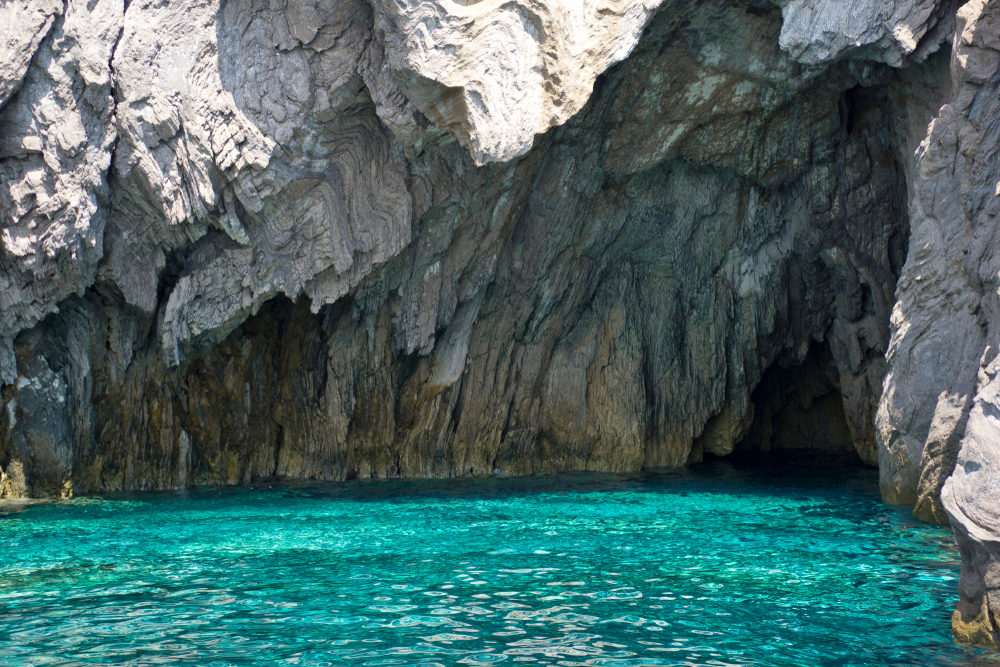
The crystalline waters of Basiluzzo
It is a bay with a very particular shape, as it resembles an amphitheatre. Another beach that deserves an anchorage is the Calcara beach, on the north-east side of the island. In 20 minutes you can easily reach on foot from the centre. This beach is very characteristic because it is of volcanic origin. We finish the overview with Cala Degli Zimmari which is the only sandy beach with red tones, an aspect that makes it unique in its kind.
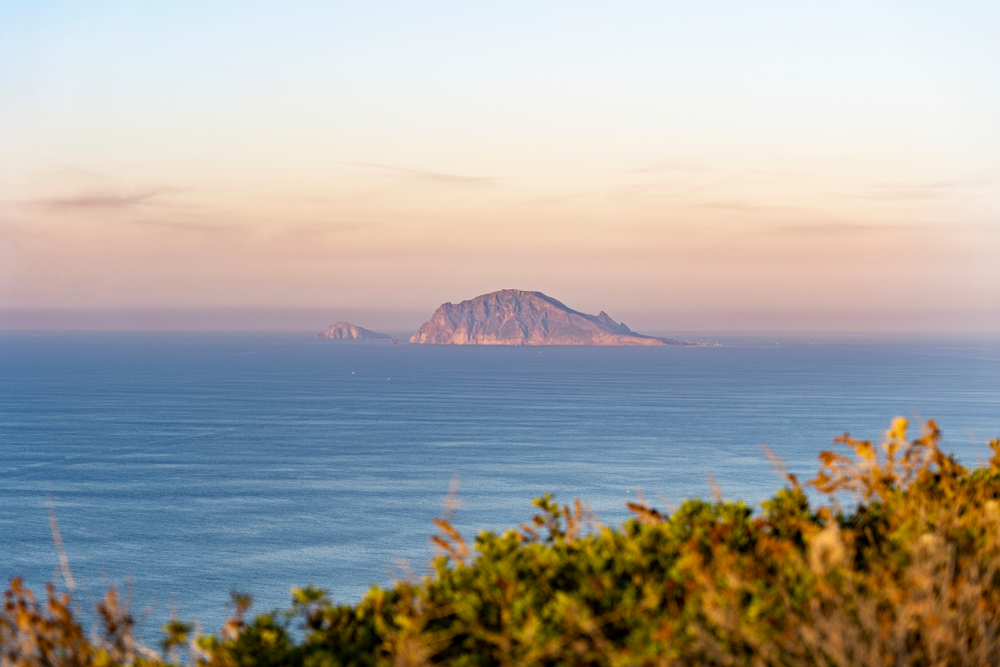
Romantic Panarea
Stromboli is the only island in the archipelago where volcanic activity is active, eruptions occur on average every 15/20 minutes. The inhabitants of the island call it "Iddu" (He), to show that the volcano is part of them, like a person or a very dear entity, as if to exorcise the fact of living at the foot of an active volcano.
Along the northeastern coast of the island, you will find the harbour area. As soon as you land at Punta Scari, you immediately feel the magic of this island with its high cliffs interspersed with small beaches of black sand and coves and caves where the white architecture of the Aeolian create a pleasant contrast with the blue sea and the black of the beaches. Along a road that from the port goes directly into the town you will find typical stores where you can taste local dishes.
From the square of San Vincenzo, which takes its name from the homonymous church, begins a climb that leads to the top of the volcano Stromboli. Not to be missed is the Fire Festival at the end of August: fire is the symbolic element of the island of Stromboli. The festival includes circus shows, dances and music. In the hamlet of Scari, in July, the celebrations in honour of St. Vincent are definitely worth a stop if you find yourself in those parts in July.
Recent studies have dated the lava at the centre of Grande Zucco at more than 1 million years, making it the oldest known place on the entire archipelago. Of the seven sisters, Filicudi is probably the one with the most beautiful marine attractions. It is a jagged coastline made of rocks overlooking the sea, stacks, submerged rocks, ancient artefacts, a changing coastline sometimes rich in vegetation and sometimes barren. And then caves, ravines, beaches and thousands of places where you can drop anchor and enjoy the crystal clear sea. If you sail to Filicudi, a must for lovers of swimming and snorkelling is the Grotta del Bue Marino on the west coast of the island.
Those who have been there recommending the outward observing the colours of the seabed and the return on the back to admire the rocky walls. Inside, you can hear a sound similar to the mooing of the ox ('bue' in Italian)!
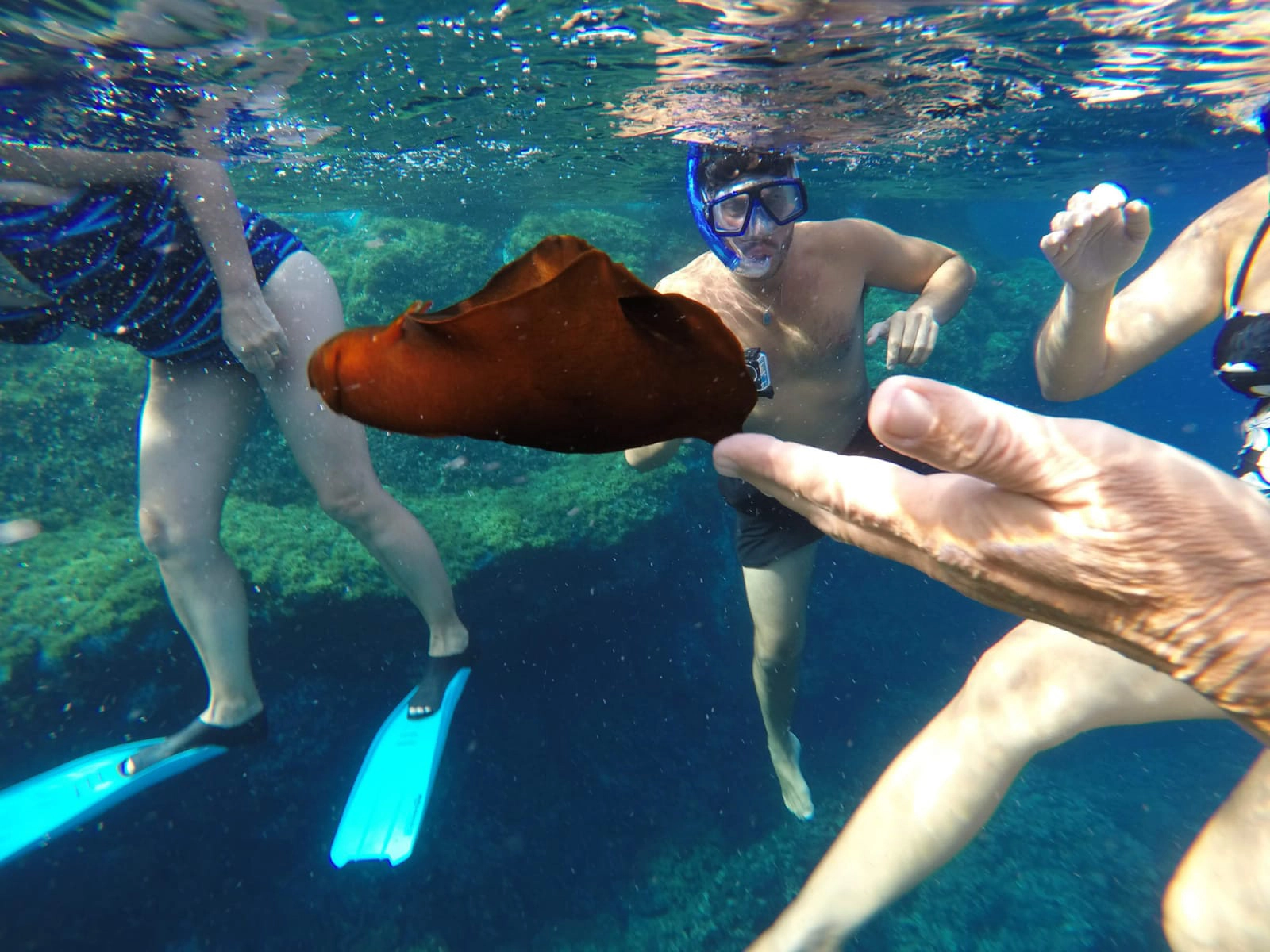
Filicudi Wildlife Association Researchers in Action
For years the Filicudi WildLife Conservation Association has been involved in applied research for the conservation of cetaceans and sea turtles in the Aeolian Archipelago in collaboration with public and private research organizations and many Italian universities. In one of our recent interviews, we met Chiara, who co-founded the Association and has been working as a researcher in the Aeolian Islands for several years. Find out more in our article here.
In August, do not miss Filicudi between myths and legends: the festivities consist of a procession of boats decorated for the festivities directed towards the cave of the Bue Marino, including improvised banquets and numerous musical groups.
A perfect place to reach by sailing boat. The coast is steep and at the north-eastern tip of the island, the rocks fall perpendicularly into the sea. The eastern slopes of the island are almost completely covered with terraces that indicate the agricultural activities of the past. The western slopes remain wilder and uninhabited due to their slope and inaccessibility.
This is an anchorage for crews looking for a secluded spot away from the mundane, a paradise in the middle of the wilderness. Land the boat with a full tank of water and a good supply of food and drink; there are few stores and restaurants on the island.
The second-largest island of the Aeolian Islands considered the greenest island of the Archipelago. It is the only island with its own freshwater spring, connected to the volcanic soil. On the slopes of the two extinct volcanoes, you'll find cultivated vines from which the famous sweet wine Malvasia also known as "Nectar of the Gods" is produced. It is not only the amber-coloured wine that makes this island famous, the delicious Salinian capers that will often flavour some of the local dishes.
In honour of capers and Malvasia, several festivals take place during a gastronomical festival on the last weekend of June.
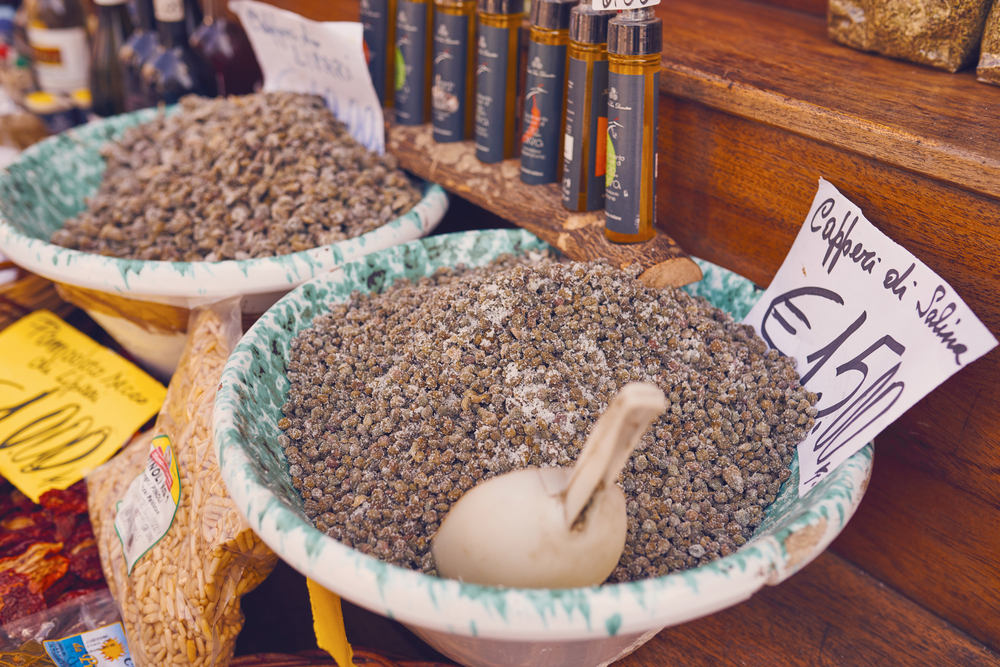
Capers in a local Salina market
You can moor at the tourist port Porto delle Eolie and go to get lost among the streets of the village, among palms and maritime pines. The ancient churches and houses, the colourful boats of fishermen and the scent of Sicily welcome tourists. To disembark in the village of Rinella you can dock at the buoy field: there is a small beach close to the typical Aeolian houses.
At Lingua bay, you can anchor in front of the village and go down with the tender; the small white houses dot the slopes of the mountain, covered with rocks and Mediterranean vegetation. The scents, the warmth, the inhabitants reveal the typical Sicilian atmosphere. The bay of Pollara is a jewel: rocks caressed by the wind and the waves, rounded shapes together with pointed ones, a triumph of nature, which reveals the signs of time. In Pollara you are surprised to see the shelter of the boats of the fishermen: a staircase carved into the rock, sheltered from the winds and storms. An intimate corner, enclosed in a mini bay, to be discovered by sailing near the coast.
In Salina, don't miss the Sagra del Cappero (Festival of Capers), on the first Sunday of June and on August 7 which consists of a procession of boats accompanied by popular folklore songs and light games, in honour of the local saint San Gaetano.
Lipari, whose municipality collects all the islands except that of Salina. The largest and most populated of the Aeolian Islands, Lipari is characterized by a rocky coastline and beaches of pumice stone that gives the sea a lighter colour than the other islands.
The city and the largest port in Lipari. The main attraction is the castle surrounded by imposing walls, dating back to the 16th century by the Spanish. It is worth visiting the Contrada Diana Archaeological Park. In town, you can also visit the Museo Eoliano (located in the Castle of Lipari) and one of the richest Sicilian necropolis, as well as numerous churches and the bishop's palace. The historical centre, the Cathedral, the port: Lipari is the most interesting of the islands in terms of historical monuments to visit if you want to take a break from life on board.
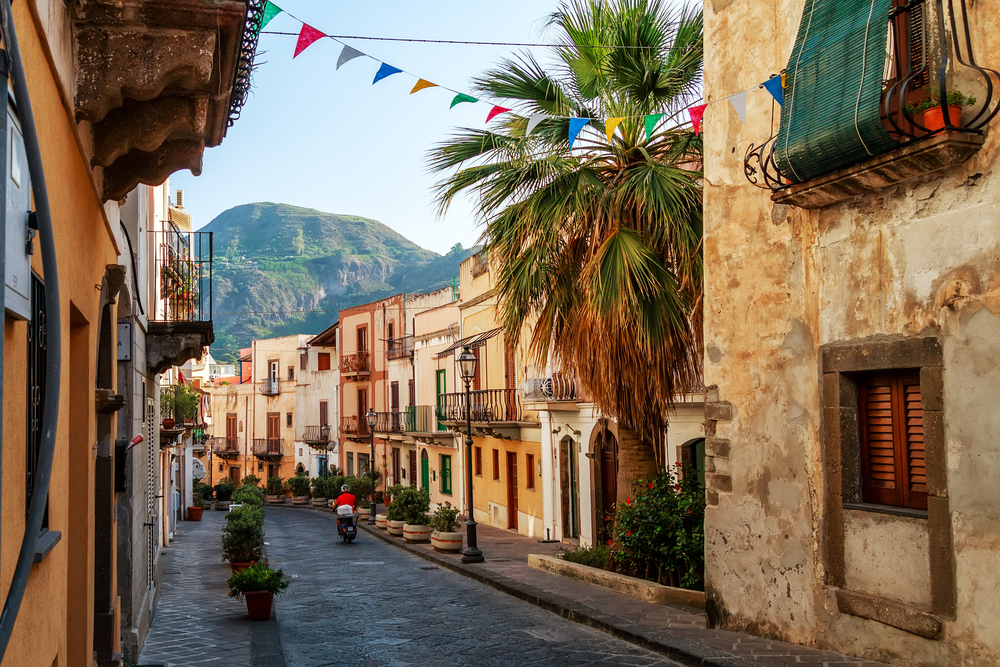
Quaint Lipari alleys
Given its central position in the Archipelago, in the bay of Lipari, you have more possibilities to spend a night in the port, even in high season. The island has a marina, ports, floating docks and many anchorages, where you can find protection from all winds. Lipari is the ideal stop for food shopping and whatever you may need on a boat.
Most of the landings are located on the eastern side of the island: Marina Lunga, Marina Corta and Pignataro. Without a doubt, Lipari is an excellent starting point on your sailing holiday around the wonderful Aeolian Islands.
In Marina Lunga, so-called the long bay of Lipari, there are several private floating docks, which offer services of water, electricity, dead body mooring, mooring assistance. In the northern part of the bay, there is the Port of Pignataro, a private marina with all services and also protected from the sirocco. In the historical centre of the town of Lipari there is Marina Corta, an extremely picturesque little port, but intended only for small local boats.
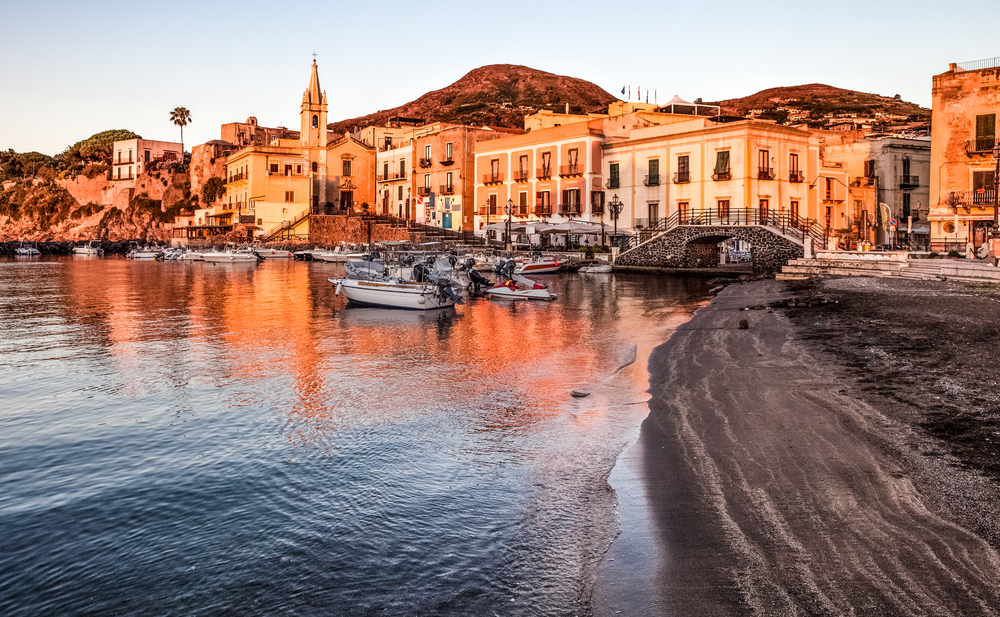
Dawn-lit houses in Lipari
Not to be missed in Lipari is the International Festival of Folklore, with artists from all over the world; the traditional festival of San Cristoforo in the seaside village of Canneto; the festival of San Bartolomeo patron (August), the most important of the archipelago with processions, markets and fireworks.
Together with the base of Capo d'Orlando, Portorosa is the ideal starting point to reach the Aeolian Islands, both only 15 miles away from the islands. We met up with Lillo, Portorosa's base manager, who shares valuable advice for the traveller thinking of renting a boat in the Aeolian Archipelago - all topped off with tips on where to dive and where to sample Aeolian delicacies from a true connoisseur of the place!

Our regular email newsletters include information about our boats, holiday ideas, destination insights and cultural briefings. You can unsubscribe at any time and we'll treat your data with respect, never passing on your details to third parties. Find full details of our data management in our Privacy policy page
By signing up, I agree to Sailogy's T&C's and Privacy policy

Looking for inspiration for your next sailing holiday? Packed with insights on trending sailing destinations plus stories from expert sailors and first-timers, our brand new digital magazine - Magister Navis - will guide your way to your next sail.
View magazine